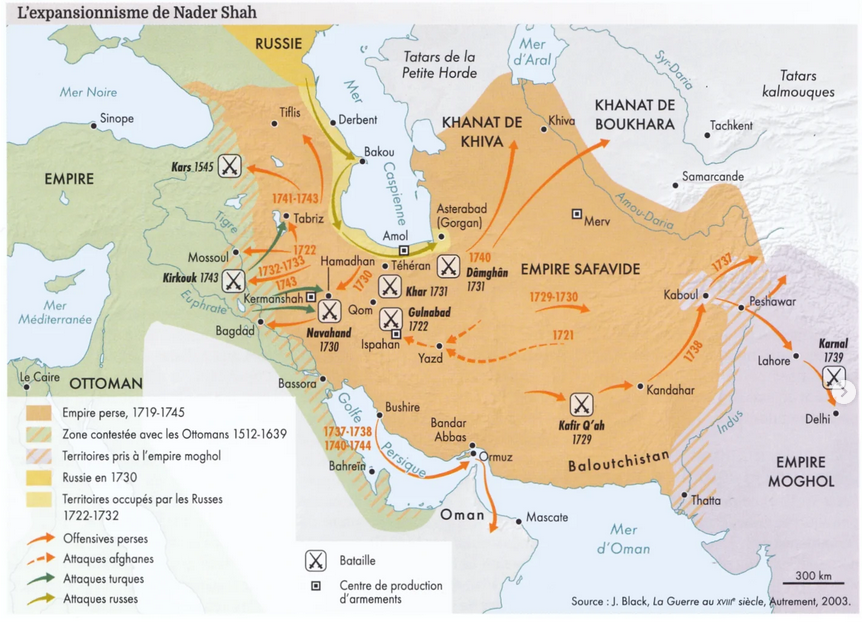Persia under Nader Shah Map


David Chen
Data Visualization Specialist
David Chen is an expert in transforming complex geographic datasets into compelling visual narratives. He combines his background in computer science ...
Geographic Analysis
What This Map Shows
The "Persia under Nader Shah Map" provides a detailed representation of the Persian Empire during the reign of Nader Shah from 1736 to 1747. Not only does this map illustrate the geographical boundaries of Persia at that time, but it also highlights key territories that were either conquered or influenced by Nader Shah. The map serves as a crucial historical document, showcasing the empire's expanse, including regions that now belong to modern-day Iran, Afghanistan, Pakistan, and parts of Central Asia.
Deep Dive into Persia under Nader Shah
Nader Shah's ascension to power marked a significant turning point in Persian history. Following the decline of the Safavid dynasty, Persia faced internal strife and external threats. Nader, a military genius and ambitious leader, sought to restore Persia to its former glory and expand its territories. Interestingly, he is often regarded as one of the last great Persian emperors, and his military campaigns reshaped the political landscape of the region.
The map vividly illustrates the vastness of Nader Shah's conquests. By the peak of his rule, he had extended Persian influence into territories that included parts of the Ottoman Empire, the Mughal Empire in India, and even into modern-day Georgia and the Caucasus. His military campaigns were characterized by remarkable speed and brutality. For instance, his invasion of India in 1739 resulted in the capture of Delhi and immense plunder, which significantly enriched Persia. This wealth was used to fund further military campaigns and solidify his rule.
What’s fascinating is how Nader Shah's military innovations changed warfare in the region. He introduced a more organized and disciplined army, which was instrumental in his conquests. His tactics often involved surprise attacks and a deep understanding of his enemies’ weaknesses. This strategic cunning allowed him to outmaneuver larger forces and secure victories against formidable opponents.
In addition to his military prowess, Nader Shah is known for the administrative reforms he implemented within Persia. He sought to centralize power and reduce the influence of local governors who had become increasingly autonomous. The map not only depicts territorial expansion but also reflects the socio-political changes occurring during his reign. The shift from a decentralized system to a more centralized authority helped solidify the power of the monarchy, although it was often met with resistance from various factions within the empire.
Regional Analysis
Examining the map closely, we can observe the key regions of Persia during Nader Shah's rule. The central area, encompassing modern-day Iran, was the heart of his empire. However, the territories to the east and west also hold significant importance. For instance, the areas of modern Afghanistan and parts of the Indian subcontinent were crucial for trade and military logistics.
The eastern provinces, rich in resources and strategic locations, became focal points for Nader’s campaigns. Interestingly, the political dynamics in these areas were complex, with various tribal groups often at odds. Nader Shah deftly navigated these challenges to assert control. In contrast, the western regions, particularly those bordering the Ottoman Empire, were marked by ongoing conflicts. Nader's confrontations with the Ottomans were significant, as they reflected the broader struggles for power that defined the era.
Regions like Khorasan, which Nader Shah sought to secure, were vital not just for their economic resources but also for their role as a buffer against potential invasions from the north. The map highlights how these regions were interconnected, with trade routes facilitating the movement of goods and troops, thus playing an essential role in the empire's economic stability.
Significance and Impact
Understanding the geographical context of Persia under Nader Shah is crucial for grasping the complexities of Middle Eastern history. The map serves as a reminder of how borders have shifted over time due to war, diplomacy, and the ambitions of leaders. Nader Shah's reign, though relatively short-lived, had lasting implications for the region.
The impact of Nader Shah's campaigns is still felt today, as the modern borders of Iran and its neighboring countries were influenced by the territorial divisions established during his time. Moreover, Nader's legacy is a double-edged sword; while he is celebrated for his military achievements, his brutal tactics led to widespread suffering and resentment among the conquered peoples.
Interestingly, as we analyze current geopolitical trends, we see echoes of Nader Shah's time. The region remains a complex tapestry of ethnicities and historical grievances, and understanding this map offers valuable insights into the dynamics of power, identity, and conflict that continue to shape the Middle East today. As we move forward, it is essential to acknowledge these historical narratives to grasp the intricate relationships that define the region’s future.
Visualization Details
- Published
- October 28, 2025
- Views
- 14
Comments
Loading comments...